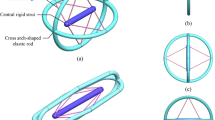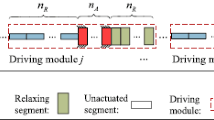Abstract
The earthworm has been attracted much attention in the research and development of biomimetic robots due to their unique locomotion mechanism, compact structure, and small motion space. This paper presents a new design and prototype of a worm-inspired metameric robot with a movement pattern similar to that of earthworms. The robot consists of multiple telescopic modules connected in series through joint modules. The telescopic module mimics the contraction and elongation motion modes of the earthworm segments. A kinematic and dynamic analysis is conducted on the telescopic module, and an input torque calculation method is provided to ensure sufficient friction between the robot and the pipe wall. The gait modes of the prototype robot for straight and turning locomotion are introduced, and these modes are extended to robots constructed by different numbers of telescopic modules. In addition, a method is proposed to increase the friction between the robot and the pipe wall in the aforementioned gait modes without changing the robot structure, thereby improving the robot’s motion ability in pipelines. The theoretical model of gait modes has also been validated through gait experiments. The findings of this paper would provide a useful basis for the design, modeling, and control of future worm inspired robots.













Similar content being viewed by others
Data Availability
The authors declare that the data supporting the findings of this study are available within the paper and its Supplementary Information files. Should any raw data files be needed in another format they are available from the corresponding author upon reasonable request. Source data are provided with this paper.
References
Liu, J. C., Zhang, C., Liu, Z. N., Zhao, R., An, D., Wei, Y. G., Wu, Z. X., & Yu, J. Z. (2021). Design and analysis of a novel tendon-driven continuum robotic dolphin. Bioinspiration & Biomimetics, 16(6), 065002.
Schmickl, T., Hamann, H., Wörn, H., & Crailsheim, K. (2009). Two different approaches to a macroscopic model of a bio-inspired robotic swarm. Robotics and Autonomous Systems, 57(9), 913–921.
Omari, M., Ghommem, M., Romdhane, L., & Hajj, M. R. (2022). Performance analysis of bio-inspired transformable robotic fish tail. Ocean Engineering, 244, 110406.
Cyr, A., Avarguès-Weber, A., & Thériault, F. (2017). Sameness/difference spiking neural circuit as a relational concept precursor model: A bio-inspired robotic implementation. Biologically Inspired Cognitive Architectures, 21, 59–66.
Ravalli, A., Rossi, C., & Marrazza, G. (2017). Bio-inspired fish robot based on chemical sensors. Sensors & Actuators: B Chemical, 239, 325–329.
Bachega, R. P., Pires, R., & Campo, A. B. (2013). Force sensing to control a bio-inspired walking robot. IFAC Proceedings Volumes, 46(7), 105–109.
Liu, Y. W., Sun, S. W., Wu, X., & Mei, T. (2015). A wheeled wall-climbing robot with bio-inspired spine mechanisms. Journal of Bionic Engineering, 12(1), 17–28.
Zhang, Y. F., Yang, D. Z., Yan, P. N., Zhou, P. W., Zou, J., & Gu, G. Y. (2022). Inchworm inspired multimodal soft robots with crawling, climbing, and transitioning locomotion. IEEE Transactions on Robotics, 38(3), 1806–1819.
Burgner-Kahrs, J., Rucker, D. C., & Choset, H. (2015). Continuum robots for medical applications: A survey. IEEE Transactions on Robotics, 31(6), 1261–1280.
Gao, Z. H., Shi, Q., Fukuda, T., Li, C., & Huang, Q. (2019). An overview of biomimetic robots with animal behaviors. Neurocomputing, 332, 339–350.
Nakamura, T., Kato, T., Iwanaga, T., & Muranaka, Y. (2006). Peristaltic crawling robot based on the locomotion mechanism of earthworms. IFAC Proceedings Volumes, 39(16), 139–144.
Guetta, O., Shachaf, D., Katz, R., & Zarrouk, D. (2023). A novel wave-like crawling robot has excellent swimming capabilities. Bioinspiration & Biomimetics, 18(2), 026006.
Chen, R., Tao, X. R., Cao, C. Y., Jiang, P., Luo, J., & Sun, Y. (2023). A soft, lightweight flipping robot with versatile motion capabilities for wall-climbing applications. IEEE Transactions on Robotics, 39(5), 3960–3976.
Hemingway, E. G., & O’Reilly, O. M. (2020). Continuous models for peristaltic locomotion with application to worms and soft robots. Biomechanics and Modeling in Mechanobiology, 20(1), 5–30.
Whitman, J., Zevallos, N., Travers, M., & Choset, H. (2018). Snake robot urban search after the 2017 Mexico City earthquake. IEEE International Symposium on Safety, Security, and Rescue Robotics (SSRR). Philadelphia, PA, USA, 1–6.
Roslin, N. S., Anuar, A., Jalal, M. F. A., & Sahari, K. S. M (2012). A review: Hybrid locomotion of in-pipe inspection robot. Procedia Engineering, 41, 1456–1462.
Guo, B. Y., Liu, Y., Birler, R., & Prasad, S. (2020). Self-propelled capsule endoscopy for small-bowel examination: Proof-of-concept and model verification. International Journal of Mechanical Sciences, 174, 105506.
Naderi, N., Najarian, S., Hosseinali, A., & Karevan, H. (2013). Modeling and dynamic analysis of the worm-like part of an innovative robot applicable in colonoscopy. International Journal of Medical Robotics & Computer Assisted Surgery, 9(3), 371–378.
Kwon, J., Park, S., Park, J., & Kim, B. (2007). Evaluation of the critical stroke of an earthworm-like robot for capsule endoscopes. Proceedings of the Institution of Mechanical Engineers Part H Journal of Engineering in Medicine, 221(4), 397–405.
Jian, X. G., Wang, Y. F., & Yang, P. C. (2012). Research progress on biomimetic robots based on the mechanism of earthworm peristalsis. Chinese Journal of Engineering Machinery, 10(03), 359–363.
Zhang, B. Y., Fan, Y. W., Yang, P. H., Cao, T. L., & Liao, H. G. (2019). Worm-like soft robot for complicated tubular environments. Soft Robotics, 6(3), 399–413.
Boxerbaum, A. S., Shaw, K. M., Chiel, H. J., & Quinn, R. D. (2012). Continuous wave peristaltic motion in a robot. The International Journal of Robotics Research, 31(3), 302–318.
Coyle, S., Majidi, C., LeDuc, P., & Hsia, K. J. (2018). Bio-inspired soft robotics: Material selection, actuation, and design. Extreme Mechanics Letters, 22, 51–59.
Hu, Q. Q., Dong, E. B., & Sun, D. (2023). Soft modular climbing robots. IEEE Transactions on Robotics, 39(1), 399–416.
Lam, T. L., & Xu, Y. S. (2011). Climbing strategy for a flexible tree climbing robot—treebot. IEEE Transactions on Robotics, 27(6), 1107–1117.
Ai, X. P., Yue, H. M., & Wang, W. D. (2023). Crawling soft robot exploiting wheel-legs and multimodal locomotion for high terrestrial maneuverability. IEEE Transactions on Robotics, 39(6), 4230–4239.
Böhm, V., Kaufhold, T., Zeidis, I., & Zimmermann, K. (2016). Dynamic analysis of a spherical mobile robot based on a tensegrity structure with two curved compressed members. Archive of Applied Mechanics, 87(5), 853–864.
Umedachi, T., Vikas, V., & Trimmer, B. A. (2016). Softworms: The design and control of non-pneumatic, 3d-printed, deformable robots. Bioinspiration & Biomimetics, 11(2), 025001.
Bi, Z. H., Zhou, Q. Y., & Fang, H. B. (2023). A worm-snake-inspired metameric robot for multi-modal locomotion: Design, modeling, and unified gait control. International Journal of Mechanical Sciences, 254, 108436.
Song, C. W., Lee, D. J., & Lee, S. Y. (2016). Bioinspired segment robot with earthworm-like plane locomotion. Journal of Bionic Engineering, 13(2), 292–302.
Jin, Y. C., Li, J., Liu, S. Y., Cao, G. Q., & Liu, J. L. (2023). A worm-inspired robot based on origami structures driven by the magnetic field. Bioinspiration & Biomimetics, 18(4), 046008.
Mei, D., Zhao, X., Tang, G. Q., Wang, J. F., Zhao, C., Li, C. X., & Wang, Y. J. (2022). A single-joint worm-like robot inspired by geomagnetic navigation. Machines, 10(11), 1040.
Sattarov, R. R., & Almaev, M. A. (2017). Electromagnetic worm-like locomotion system for in-pipe robots: design and vibration-driven motion analysis. International Scientific and Technical Conference on Dynamics of Systems, Mechanisms and Machines, Omsk, Russia, 1–6.
Zarrouk, D., Sharf, I., & Shoham, M. (2012). Experimental validation of locomotion efficiency of worm-like robots and contact compliance. IEEE International Conference on Robotics & Automation, Saint Paul, MN, USA, 5080–5085.
Acknowledgements
The authors thank the financial support from the National Natural Science Foundation of China (Grants No. 52275031).
Author information
Authors and Affiliations
Corresponding author
Ethics declarations
Conflict of interest
The authors declare no conflict of interest.
Additional information
Publisher’s Note
Springer Nature remains neutral with regard to jurisdictional claims in published maps and institutional affiliations.
Electronic Supplementary Material
Below is the link to the electronic supplementary material.
Supplementary Material 1
Supplementary Material 2
Supplementary Material 3
Supplementary Material 4
Rights and permissions
Springer Nature or its licensor (e.g. a society or other partner) holds exclusive rights to this article under a publishing agreement with the author(s) or other rightsholder(s); author self-archiving of the accepted manuscript version of this article is solely governed by the terms of such publishing agreement and applicable law.
About this article
Cite this article
Liu, Y., Shi, Q. & Chen, Z. Design and Gait Planning of a Worm-inspired Metameric Robot for Pipe Crawling. J Bionic Eng (2024). https://doi.org/10.1007/s42235-024-00497-4
Received:
Revised:
Accepted:
Published:
DOI: https://doi.org/10.1007/s42235-024-00497-4




